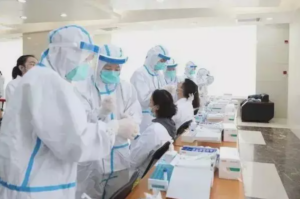
World’s First Oral Drug for New Coronary Severe Illness Expected to be Approved
The FDA remains positive about Veru’s new coronary artery disease oral drug Sabizabulin receiving an EUA (Emergency Use Authorization), and Sabizabulin may be the first new coronary artery disease oral drug to be marketed globally.
Emergency Use Authorization is a special form of authorization provided by the FDA when the announcement of health is at risk, referring to the United States means that the government authorizes the emergency use of drugs, vaccines or medical devices that are not fully approved after a full evaluation in an emergency public health situation.
Veru submitted an EUA application for Sabizabulin to the FDA in June of this year, and an expert advisory committee was convened on November 9, U.S. time.
On November 9, Zhang Hongtao, former research associate professor at the University of Pennsylvania School of Medicine and founder of Hangzhou Sedecom Biotechnology Co., Ltd, told Interface News that the Expert Advisory Committee will have a significant impact on whether the FDA confirms the authorization to allow the emergency use of Sabizabulin. However, there have been previous cases where the expert advisory committee agreed with the drug in question, but the FDA ultimately did not allow it to be approved.
Zhang Hongtao analyzed the phase III clinical data of Sabizabulin showing a relative reduction of 55% in the risk of death in patients with moderate to severe new coronary artery disease, which indicates that the drug’s effectiveness is clinically proven. Currently, there is no other oral drug for new crowns on the market that achieves the same reduction in risk of death from severe disease as Sabizabulin, and Sabizabulin’s scarcity makes it much more likely to receive emergency use authorization from the FDA.
Veru stock rose for two days on the news, quoting $15.01 per share.
Sabizabulin is a novel oral small molecule bisindole microtubulin inhibitor developed by Veru that blocks intracellular transport of neocoronavirus along microtubules by binding to the “colchicine binding sites” of alpha and beta microtubule proteins and inhibiting microtubule protein depolymerization at low nanomolar concentrations. At the same time, the drug has an anti-inflammatory effect, which can prevent cytokine storm caused by neo-coronavirus infection.
Zhang Hongtao introduced that the currently approved oral neostriatal drugs on the market are developed for the early development of the virus from the perspective of inhibiting viral replication, while patients with moderate to severe neostriatal infections have an overreaction of their body’s immune system due to neostriatal virus infection. Sabizabulin produced a relatively good modulatory effect on the related immune response by binding to the “colchicine binding sites” of alpha and beta microtubule proteins.
Zhang Hongtao said that regulation of immune response is a complex process in the clinic, and there are many factors that lead to neoconcentration of severe disease, so it cannot be predicted and can only be validated against each other by back-propagation through clinical experimental area validation. Previously, there are also many drugs similar to Sabizabulin, but none of the pathways they target have been validated as critical factors in clinical trials.
Clinical data previously disclosed by Veru showed that the phase III study of Sabizabulin included 210 patients hospitalized with moderate to severe neocoronary pneumonia. Patients received either sabizabulin plus standard of care treatment or placebo plus standard of care, which included raltegravir, dexamethasone, anti-IL6 receptor antibodies and JAK inhibitors.
On April 11 of this year, Veru published Phase III data on sabizabulin designed to evaluate the efficacy and safety of the drug in the treatment of patients with moderate-to-severe neocoronary pneumonia with acute respiratory distress syndrome (ARDS) and risk of death. A total of 204 subjects were enrolled in the study and randomized in a 2:1 ratio to receive Sabizabulin (9 mg, orally once daily, n=134) and placebo (n=70). Results of the interim analysis of data from the first 150 enrolled patients showed a 45% mortality rate in the placebo group (n=52) compared to a 20% mortality rate in the Sabizabulin group (n=98.) Sabizabulin reduced the relative risk of patient death by 55% (p = 0.0029), which was clinically and statistically significant. Daily oral Sabizabulin was well tolerated and had a similar safety profile compared to placebo.
In addition, Sabizabulin met the secondary endpoint. The data showed that the treatment significantly reduced the number of days patients were in the intensive care unit, the number of days on mechanical ventilation and the total number of days in the hospital.
However, the study size for Sabizabulin was small. The data analysis described above could not eliminate bias in the study results due to certain baseline imbalances between treatment groups. Other uncertainties raised by the FDA include baseline imbalances in standard of care therapies, the possibility of unmasking events due to enteral tube administration, the uncertain impact of care decision goals on all-cause mortality, negative studies of other microtubule disruptors in neocoronavirus, and differences in length of stay before enrollment.
According to Hongtao Zhang, the size of the experimental study was not a critical factor, but was primarily determined by the experimental approach of the control versus treatment groups selected, from which to determine whether the experiments conducted yielded statistically significant displayability. For example, the smaller the gap between the control group and the treatment group the larger the sample size required.
Zhang Hongtao said that the uncertainties proposed by the FDA at this time still need to be validated in real-world use. This is because it is not yet possible to determine whether the uncertainty proposed above is caused solely by the drug.


Average Rating